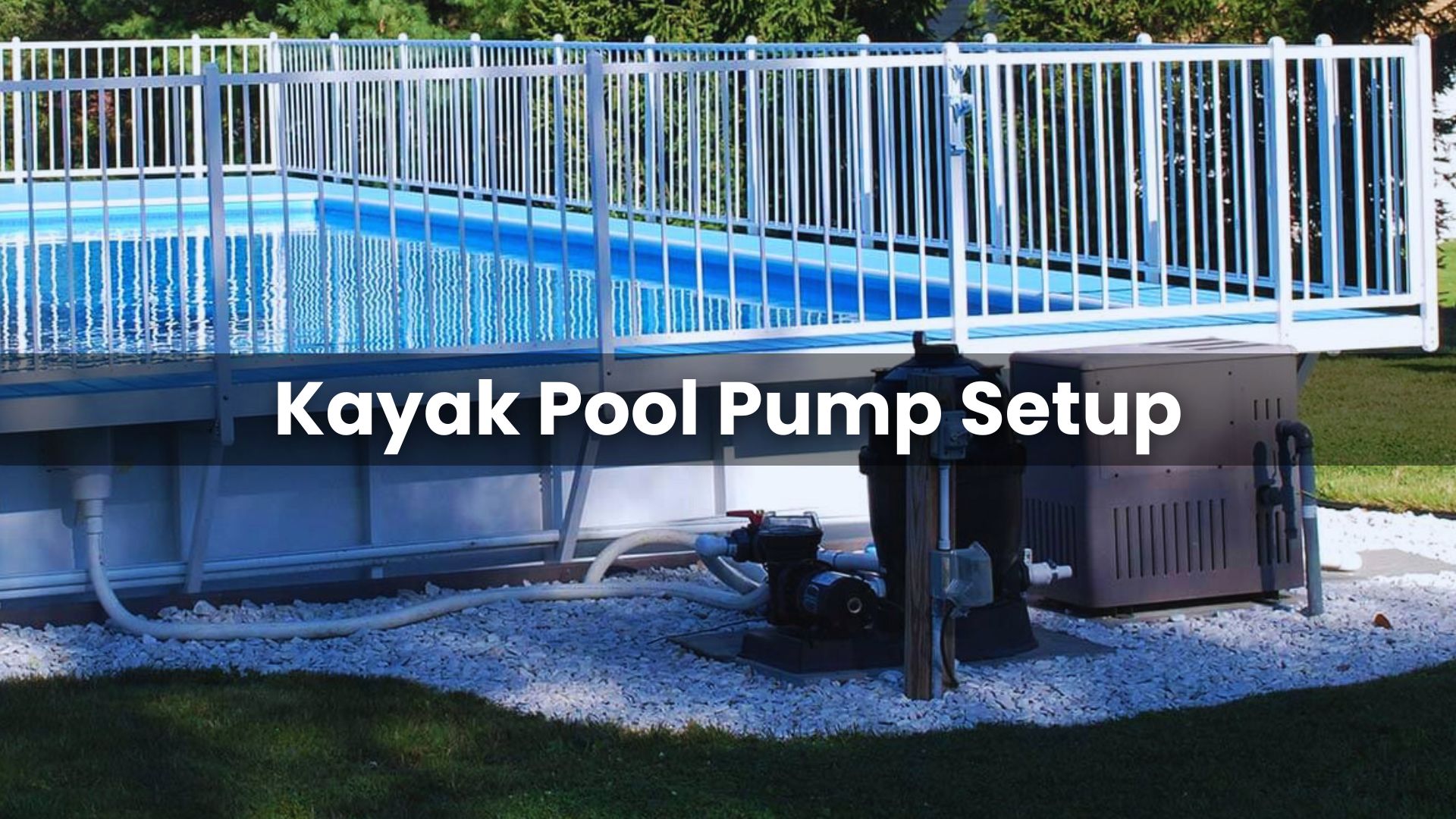Kayak pools have become increasingly popular for their unique and refreshing way to enjoy the summer. With their compact design and ease of setup, it’s no wonder why many people opt for these pools over traditional in-ground or above-ground pools. However, setting up a kayak pool pump is crucial for ensuring a safe and enjoyable experience.
In this article, we will provide a detailed guide on how to set up your kayak pool pump efficiently, covering the benefits, types of pumps, and essential steps for a hassle-free installation.
- Benefits of a Kayak Pool Pump Setup
- Choosing the Right Kayak Pool Pump for Your Needs
- Pre-Installation Checklist for Kayak Pool Pump Setup
- Step-by-Step Kayak Pool Pump Setup
- Troubleshooting Common Issues with Kayak Pool Pump Setup
- Maintaining Your Kayak Pool Pump for Optimal Performance
- Conclusion
- FAQS About Kayak Pool Pump
- What size pump do I need for my kayak pool?
- How do I know if my electrical setup is adequate for a pool pump?
- Can I install the kayak pool pump myself?
- How often should I clean or maintain my kayak pool pump?
- What are the signs that my kayak pool pump needs repair or replacement?
- Is it better to run my kayak pool pump during the day or at night?
- Can I use a solar-powered pump for my kayak pool?
Benefits of a Kayak Pool Pump Setup
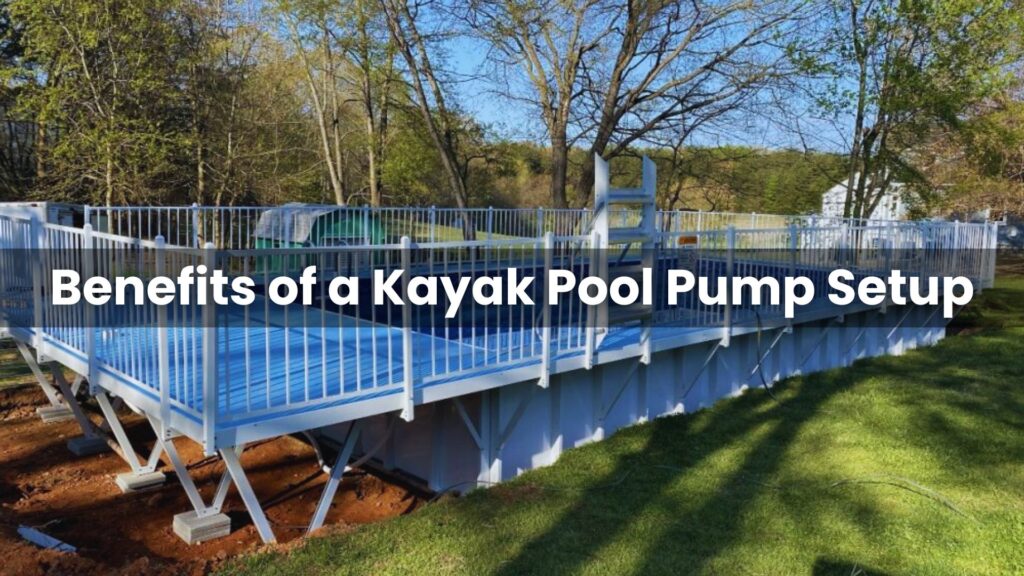
A kayak pool pump setup is essential for maintaining a pristine and safe swimming environment. Here’s why you need kayak pool pump:
Improved Water Circulation: A kayak pool pump ensures that water is continuously moving, distributing chemicals evenly and preventing algae growth. This consistent flow of water filters out debris and keeps the temperature uniform throughout the pool.
Enhanced Pool Cleanliness: With a kayak pool pump, the filtration system works more effectively. It removes impurities and microscopic particles, resulting in crystal-clear water. This means less time spent on manual cleaning and more time enjoying your pool.
Increased Safety: Proper water circulation also reduces the risk of bacteria and pathogens that can cause health issues. A well-maintained pump is a proactive step towards a hygienic swimming environment.
Reduced Maintenance: A reliable kayak pool pump minimizes the need for frequent maintenance. It prevents the buildup of debris and reduces the strain on other pool components, leading to lower repair costs and longer equipment lifespans.
Each of these benefits contributes to a more enjoyable and worry-free pool experience. The right pump setup not only keeps your pool in top condition but also saves you time and money in the long run.
Choosing the Right Kayak Pool Pump for Your Needs
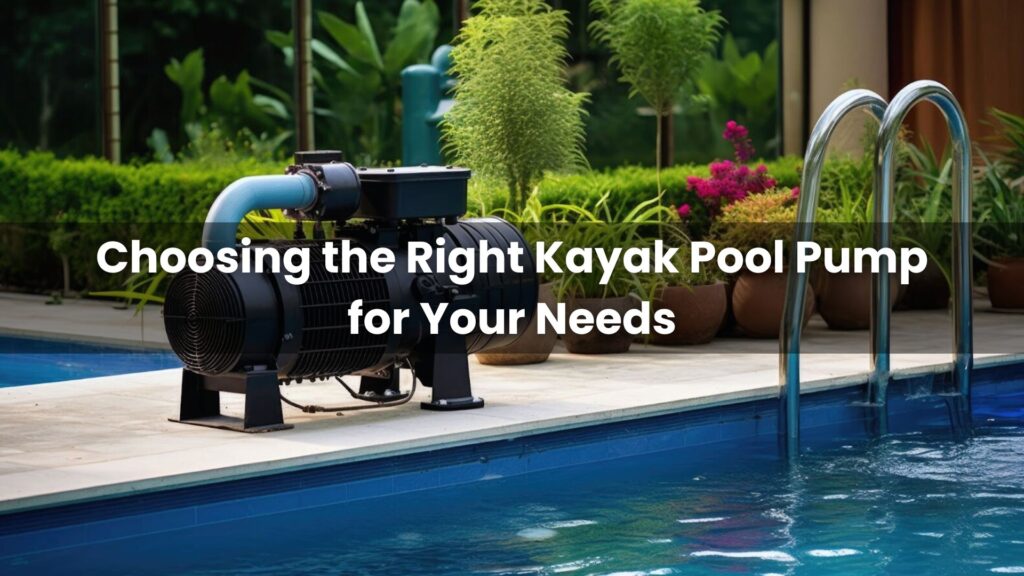
When setting up your kayak pool, selecting the right pump is a critical decision that affects not only the water quality but also the overall maintenance and operating costs. Below, we compare the three main types of kayak pool pumps: electric, solar-powered, and manual. This comparison will help you understand their features, advantages, and disadvantages, ensuring you make an informed choice for your kayak pool pump setup.
Types of Kayak Pool Pumps
| Type of Pump | Description | Advantages | Disadvantages |
| Electric Pumps | Electric pumps are powered by electricity and are known for their quick and efficient water circulation. They are commonly used due to their high performance and ease of operation. | High efficiency, ease of use, variety of sizes | Ongoing electricity costs, not eco-friendly |
| Solar-Powered Pumps | Solar-powered pumps utilize solar panels to harness energy from the sun. They are an eco-friendly option that can reduce operating costs over time, though they have a higher initial investment. | Environmentally friendly, cost-effective in the long run, low maintenance | Higher initial cost, efficiency depends on weather |
| Manual Pumps | Manual pumps require physical effort to operate and are typically used for smaller pools or as a backup system. They are the most affordable and portable option. | No operating costs, portable | Labor-intensive, less efficient |
Each type of pump offers unique benefits and drawbacks. Electric pumps are a go-to for their efficiency but come with higher operational costs. Solar-powered pumps promise eco-friendliness and cost savings in the long run, albeit with a dependency on sunny conditions. Manual pumps, while not as efficient, offer a no-cost operation and are easy to transport.
Pre-Installation Checklist for Kayak Pool Pump Setup
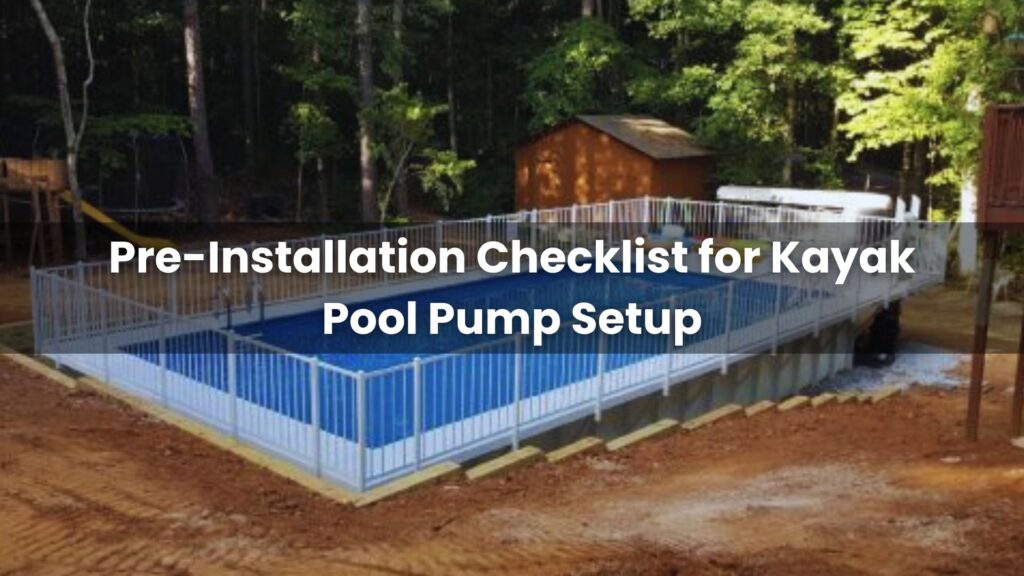
Embarking on the installation of a kayak pool pump requires careful planning and attention to detail. To ensure a smooth setup process, it’s essential to follow a pre-installation checklist that will guide you through the necessary steps and considerations. This checklist is designed to help you prepare for the installation, ensuring that all aspects of the setup are accounted for and that your pool pump operates efficiently and safely.
Before You Start: Essential Pre-Installation Steps
Pool Size and Shape Considerations: The size and shape of your pool are critical factors in determining the appropriate pump size. Calculate the volume of your pool in gallons, as this will influence the pump’s flow rate requirements. For instance, a rectangular pool’s volume can be calculated using the formula:
Length × Width × Average Depth × 7.5 = Volume in Gallons
Pump Size and Type Selection: A pump that’s too small won’t effectively circulate water, while an oversized pump can lead to unnecessary energy consumption. Kayak pools typically come with a 1.5 horsepower pump, which is suitable for most residential pools. Consider the type of pump as well whether it’s electric, solar-powered, or manual based on your preferences and environmental considerations.
Electrical Requirements and Connections: Ensure that all electrical connections comply with local codes and regulations. For pool pumps, receptacles must be GFCI-protected and located at a safe distance from the pool walls typically between 6 and 10 feet. Consult a licensed electrician to handle the electrical setup for your pool pump.
Safety Precautions: When installing your pool pump, be aware of the potential hazards, such as electrical risks and suction entrapment. Always follow the manufacturer’s safety guidelines and consider installing safety devices like a pool cover to prevent accidents when the pool is not in use. Additionally, never leave children unattended near the pool, and ensure that all pool users are aware of the safety measures in place.
Step-by-Step Kayak Pool Pump Setup
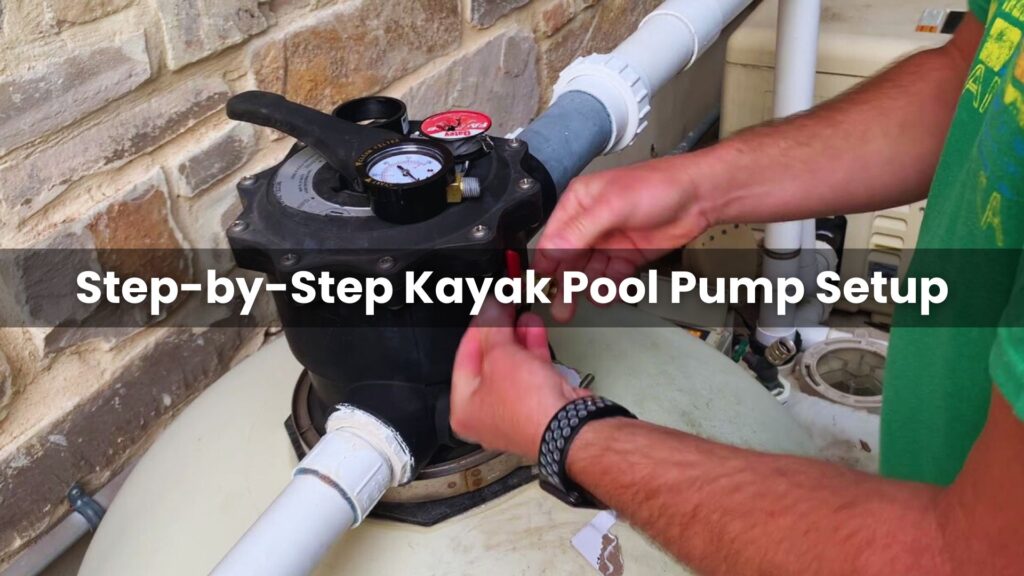
Installing a kayak pool pump is a crucial step in ensuring your pool remains clean, clear, and enjoyable. Here’s a detailed guide to help you through the process:
Step 1: Unpacking and Inspecting the Pump: Upon receiving your kayak pool pump, carefully unpack the unit. Check for any visible damage that may have occurred during shipping. Ensure all components are present and accounted for according to the manufacturer’s checklist.
Step 2: Connecting the Pump to the Pool: Position your pump close to the pool’s filtration system. Connect the pump’s intake valve to the pool’s output fitting using the provided hoses or PVC piping. Secure all connections with hose clamps or PVC cement to prevent leaks.
Step 3: Installing the Pump in the Desired Location: Choose a level and stable surface near an electrical outlet for your pump. The location should be dry and well-ventilated to prevent overheating. If necessary, place a pad or platform to elevate the pump off the ground.
Step 4: Connecting the Electrical Components: Before handling any electrical components, ensure the power supply is turned off. Connect the pump to the power source following the manufacturer’s wiring diagram. Use a dedicated circuit and ensure all connections are tight and secure.
Step 5: Testing the Pump: With all connections secure, turn on the power to the pump. Check for proper operation and observe the water flow through the pump and back into the pool. Listen for any unusual noises that could indicate a problem. If everything runs smoothly, your kayak pool pump setup is complete.
Troubleshooting Common Issues with Kayak Pool Pump Setup

When setting up your kayak pool pump, you might encounter a few common issues that can hinder the performance of your pool system. Here’s a comprehensive guide to help you troubleshoot and resolve these problems, ensuring your pool pump operates smoothly.
Pump Not Turning On: If your pump isn’t turning on, start by checking the power source. Ensure the pump is plugged in and the electrical outlet is functioning. Next, inspect the circuit breaker or GFCI outlet to see if it has tripped. If so, reset it and try turning on the pump again. If the issue persists, the problem could be with the pump’s capacitor or motor, which may require professional assistance.
Pump Not Circulating Water Properly: Proper circulation is key to maintaining pool water quality. If the pump isn’t circulating water as it should, verify that the water level in the pool is adequate to allow for proper priming. Clean the pump basket and skimmer to remove any debris that might be blocking the flow. Also, check for any clogs or obstructions in the pump’s impeller. If these steps don’t resolve the issue, there might be a leak in the suction line that needs repairing.
Leaks or Water Loss: Leaks can occur in various parts of the pump setup. Check all hose connections, valves, and the pump housing for signs of leaks. Tighten any loose fittings and replace worn-out gaskets or O-rings. If your pool is losing water, it could also be due to evaporation or splashing, but if the water loss is significant, it might indicate a leak in the pool liner or underground plumbing.
Electrical Issues: Electrical problems can range from simple fixes to more complex issues that require a professional electrician. Begin by inspecting all electrical connections for signs of wear or damage. Ensure that the pump’s wiring is intact and that there are no exposed wires or loose connections. If you’re not experienced with electrical repairs, it’s best to contact a licensed electrician to safely address any electrical issues.
Maintaining Your Kayak Pool Pump for Optimal Performance
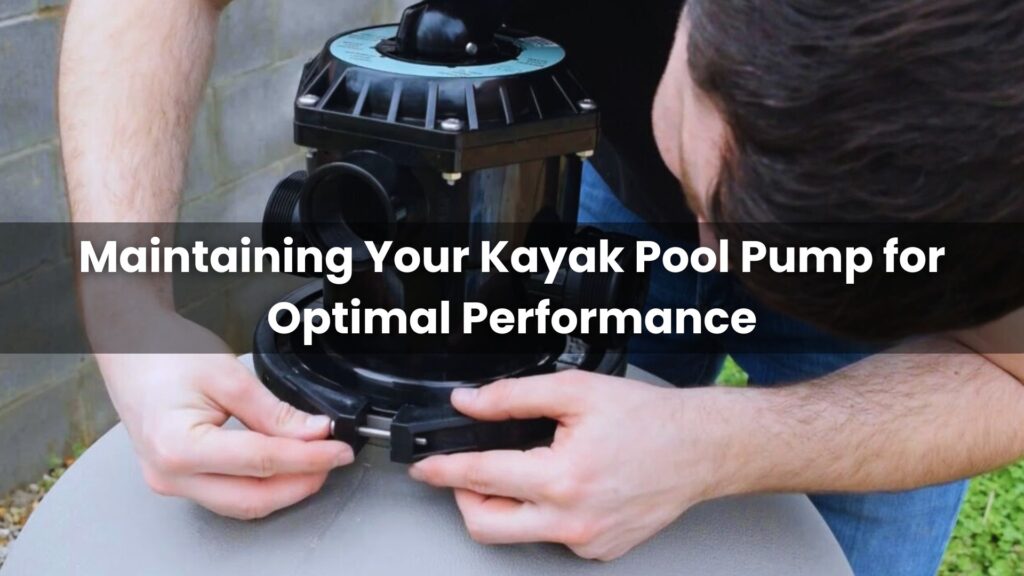
Ensuring your kayak pool pump operates at its best requires regular maintenance and attention to detail. Here are some essential tips and guidelines to keep your pool pump in top condition:
Cleaning the Pump and Filter
A clean pump and filter are vital for the efficient operation of your pool. It’s recommended to clean the pump basket and inspect the strainer pot for debris or clogs at least once a month. For the filter, the frequency of cleaning depends on the type you have:
Cartridge Filters: Should be removed and cleaned with a hose every few weeks or when the pressure gauge indicates a high reading.
Sand Filters: Require backwashing when the pressure gauge reads 8-10 psi higher than the normal operating level.
Checking and Replacing Worn-Out Parts
Regularly inspect your pump for signs of wear and tear. Check the pump lid O-ring and replace it if it’s cracked or worn. Listen for unusual noises that could indicate a problem with the motor bearings or other internal components. If you’re not comfortable with these checks, consult a professional for repair or replacement.
Monitoring Water Levels and Chemistry
Keeping an eye on the water level is crucial; it should not fall below the level of the skimmer, as this can cause the pump to run dry and overheat. Test your pool water regularly to maintain proper chemical balance. The ideal chlorine level is 1.5 to 2.0 PPM, and the pH level should be between 7.2 and 7.62. Use a reliable test kit to monitor these levels at least twice a week.
Scheduling Regular Inspections
Even with diligent maintenance, it’s wise to schedule professional inspections. A trained technician can spot issues you might miss and can ensure that your pump is running efficiently. Aim for a professional inspection at least once a year, ideally before the swimming season begins.
Conclusion
In conclusion, setting up a kayak pool pump is a crucial step in ensuring a safe and enjoyable summer experience. By following the steps outlined in this article, you can ensure a hassle-free installation and optimal performance of your kayak pool pump. Remember to choose the right pump for your needs, follow the manufacturer’s instructions, and perform regular maintenance to keep your pool running smoothly. With these tips and guidelines, you’ll be well on your way to enjoying a fun-filled summer with your kayak pool.
FAQS About Kayak Pool Pump
Below are some frequently asked questions about Kayak pool pumps, covering topics such as installation, maintenance, and operation:
What size pump do I need for my kayak pool?
The size of the pump you need depends on the volume of your pool. A general rule is that the pump should be capable of circulating the entire pool volume within 8 hours. Most residential kayak pools work well with a 1.5 horsepower pump.
How do I know if my electrical setup is adequate for a pool pump?
Your electrical setup should comply with local codes and include a GFCI-protected outlet. It’s best to consult a licensed electrician to ensure that your setup can safely handle the load of a pool pump.
Can I install the kayak pool pump myself?
If you have basic knowledge of plumbing and electrical systems, you may be able to install the pump yourself. However, for electrical connections and any complex installation steps, it’s recommended to hire a professional.
How often should I clean or maintain my kayak pool pump?
You should clean the pump basket and check the pump for debris weekly. Regular maintenance, including checking for wear and tear and ensuring the system is running smoothly, should be done monthly.
What are the signs that my kayak pool pump needs repair or replacement?
Signs that your pump may need attention include unusual noises, decreased water flow, or visible damage to the pump components. If you notice any of these signs, consult a professional for an assessment.
Is it better to run my kayak pool pump during the day or at night?
Running your pump during the night can be more energy-efficient as there is less demand on the power grid. However, if you’re using a solar-powered pump, you’ll need to run it during the day to harness solar energy.
Can I use a solar-powered pump for my kayak pool?
Yes, you can use a solar-powered pump if you live in an area with sufficient sunlight. Solar-powered pumps are eco-friendly and can reduce long-term operating costs, though they may have a higher initial investment.

Nigel Foster, born in 1952, is an esteemed sea kayaker, known for being the youngest to kayak around Iceland. His journey in kayaking started at 15 in Brighton, England. With a career beginning as a trainee instructor in Sussex, he later pursued teaching after attending Redland College, Bristol.
Foster’s notable expeditions include navigating the challenging waters of Newfoundland and the Hudson Strait. Despite facing intense conditions, his passion for kayaking never waned. He holds several British Canoe Union qualifications and has significantly contributed to the kayaking community through teaching and committee work.
In 1985, Foster expanded his horizons by assisting an expedition in Iceland and later founded his own kayaking business, sharing his expertise globally.
